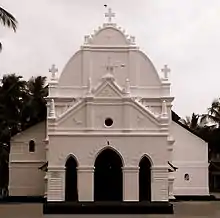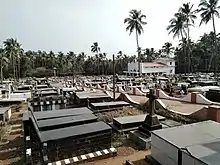St. Mary's Orthodox Cathedral, Arthat
Arthat St Mary's Orthodox Cathedral a.k.a. Arthat Valiyapally also called Paloor-Chattukulangara Church is an ancient church located in Arthat village of Thalapilly Taluk, one mile south of Kunnamkulam town, Thrissur, Kerala, India.This is the first and the oldest church in India founded in AD 52. This church is also known as Chattukulangara pally. It is believed that this church is the most ancient church in this region and is one of the Seven and Half church founded by St Thomas Apostle in AD 52. This church did not participate in the Synod of Diamper. During the invasion of Tippu Sultan the church was arsoned and later reconstructed.[1]
| Arthat St Mary's Orthodox Cathedral | |
|---|---|
 Arthat St Mary's cathedral | |
| Religion | |
| Affiliation | Malankara Orthodox Syrian Church |
| District | Thrissur |
| Province | Kerala |
| Ecclesiastical or organizational status | Cathedral |
| Year consecrated | AD 52(Apostolic era.) |
| Location | |
| Location | |
| Geographic coordinates | 10°37'58"N - 76°3'29"E |
| Architecture | |
| Type | Church |
| Style | Kerala Architecture |
| Founder | St. Thomas the Apostle |
| Direction of façade | West |
| Website | |
| http://arthatcathedral.org/ | |
History
The tradition states that St Thomas came to a region near present-day Kunnamkulam called Paloor or Judakkunnu (Yahuda kunnu) where Jews were colonized. He preached gospel to the Jews and many were converted to Christianity. The Jewish Synagogue in that area was later converted to a Christian church. This church was known as Chattukulangara pally.
When St Thomas came to Judakunnu (Jew hill), there occurred a water scarcity in that area at that time. People were in great distress and they appealed to St Thomas for help. He whipped on the land on the top of the hill and there appeared a spring of fresh water. This was later called Chattakkulam. (ml:ചാട്ടക്കുളം ) and the church near to it came to be known as Chattakkulangara pally.
After the Synod of Diamper, Aleixo de Menezes made a visit to Arthat Church whom didn't attend the Synod and submitted to Menezes. His visit was to allure and subjugate Arthat Church to the Latin leadership. However the native people strongly opposed it and loudly shouted to express their protest.
In 1789 Tippu Sultan attacked and arsoned this church. It is said in folklores that Tippu's army killed a priest in the Altar room of this church and the blood spilled over there. Since it was considered impure, some part of the Altar was cut and removed. Hence this church was also called as Vetti muricha pally(ml:വെട്ടി മുറിച്ച പള്ളി ) or cut altar church. Even now the Altar of this church remain distinct from other churches.
After the Coonan cross oath, those who made allegiance to the Roman Catholic church (Syro-Malabar Catholic Church) wanted to take over the church to their fold and because of the dispute the church was closed for a while. In 1805 with the request of the Malankara Nasranis, the then King of Cochin, Sakthan Thampuran himself came to Arthat church to resolve the problem. Both parties agreed for a lucky draw. In the lucky draw the main church and buildings were gone to the Malankara Syrians and the Stone cross of the church gone to the Syro-Malabar Catholic Church.
In 1800 Francis Buchanan visited this church and met Ittoop Malpan,(Pulikkottil Joseph Mar Dionysious I / Mar Dionysius II).
In 1806 the Arthat Padiyola (resolution) declared to break all the chains of Rome,Babel & Antioch.[2]
In 1808 Dr.Claudius Buchanan & Colonel Macauley made a visit and awarded a large gold medal to this principal church in the name of all Syrian churches in Malayalam.[3]
(Pearson Hugh, M.A., Memoirs of the life and writings of the Rev.Claudius Buchanan,D.D. Benjamin & Thomas Kite 1817 Philadelphia p. 379.)
This church has the largest cemetery(1 hectare) of all churches in Kerala. The present cemetery wall was built with the initiative of Geevarghese Mar Gregorios of Malankara.

Church architecture
The church was earlier built in Kerala Architectural style thatched with coconut palm leaves. During the attack of Tippu Sultan the church was arsoned. Later the church was restructured with wooden roof, thatched with clay tiles. Mar Dionysius II when he was a Ramban was instrumental in restructuring the church in the present state. The present structure was built during 1805-1827 CE.
Chattukulangara pally
In 1772, Kattumangattu Bishop sent a letter to Sakthan Thampuran (Sakthan thampuran page 289) which states, in Thalappilli there was only one church existing in that region, which is the Chattukulangara palli . There were 2 more chapels also present in that region viz. 1.Chiralayam 2. Pazhanji (dedicated to Geverghese sahada).
Church feud
The feud between the Patriarch faction and the Catholicos faction lead the Patriarch faction to establish another church called Arthat St Mary's Simhasana church in 1920.[4]
List of parishes separated from Arthat church
The following are the parishes separated from this church[5]
- Chiralayam
- Kottappady------>Kaveed/Perakam
- Anjoor
- Puthusseri
- Chowwannoor---->Marathamcodu/Pazhunnana/Vellarakkadu/Eyyal/Parembadam
- Guruvayoor
- Chemmannoor
- vylathoor ------>Attupuram
- Parannoor
- Chavakaadu Palayoor St thomas
2017 Storm

In 2017 June 25, a hurricane happened in Arthat causing great damages to all the churches in Arthat. The small, old St.Thomas Catholic church had to be reconstructed because of it. [6]
| Wikimedia Commons has media related to St. Mary's Orthodox Cathedral, Arthat. |
References
- Sam C.Zachariah. "Arthat St. Mary's Cathedral". Arthatcathedral.org. Retrieved 24 December 2016.
- "Orthodox Syrian Progressive Party Kunnamkulam". Orthodoxspp.org. 24 March 2008. Retrieved 24 December 2016.
- Hugh Pearson (1817). Memoirs of the life and writings of the Rev. Claudius Buchanan. Philadelphia: Benjamin & Thomas Kite. p. 379.
- "Arthat St". Syriacchristianity.info. 29 November 2002. Retrieved 24 December 2016.
- "Home". Holycrosschurcharthat.com. Retrieved 24 December 2016.
- "കുന്ദംകുളത്തുണ്ടായ ചുഴലിക്കാറ്റില് വ്യാപകനാശം: 15 പേര്ക്ക് പരിക്ക്". Mathrubhumi. 25 June 2017. Retrieved 1 March 2020.



